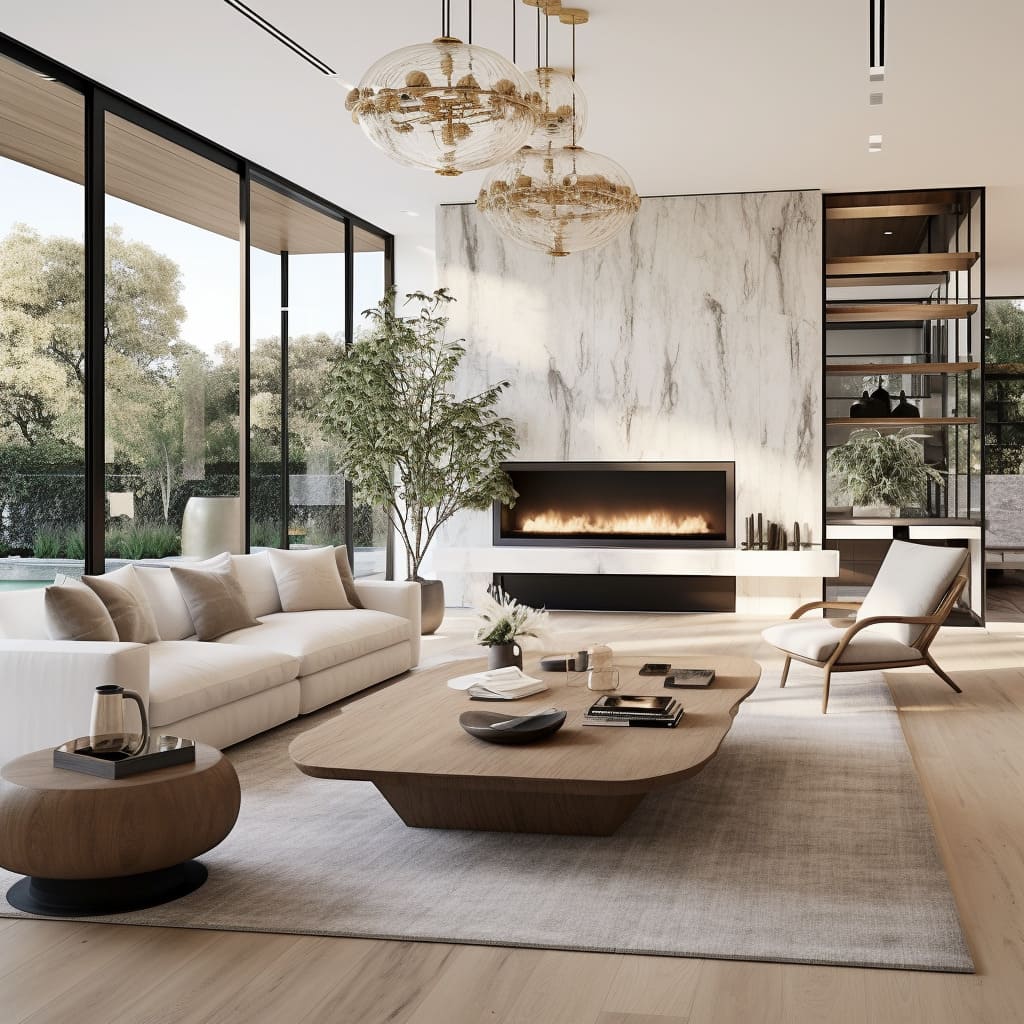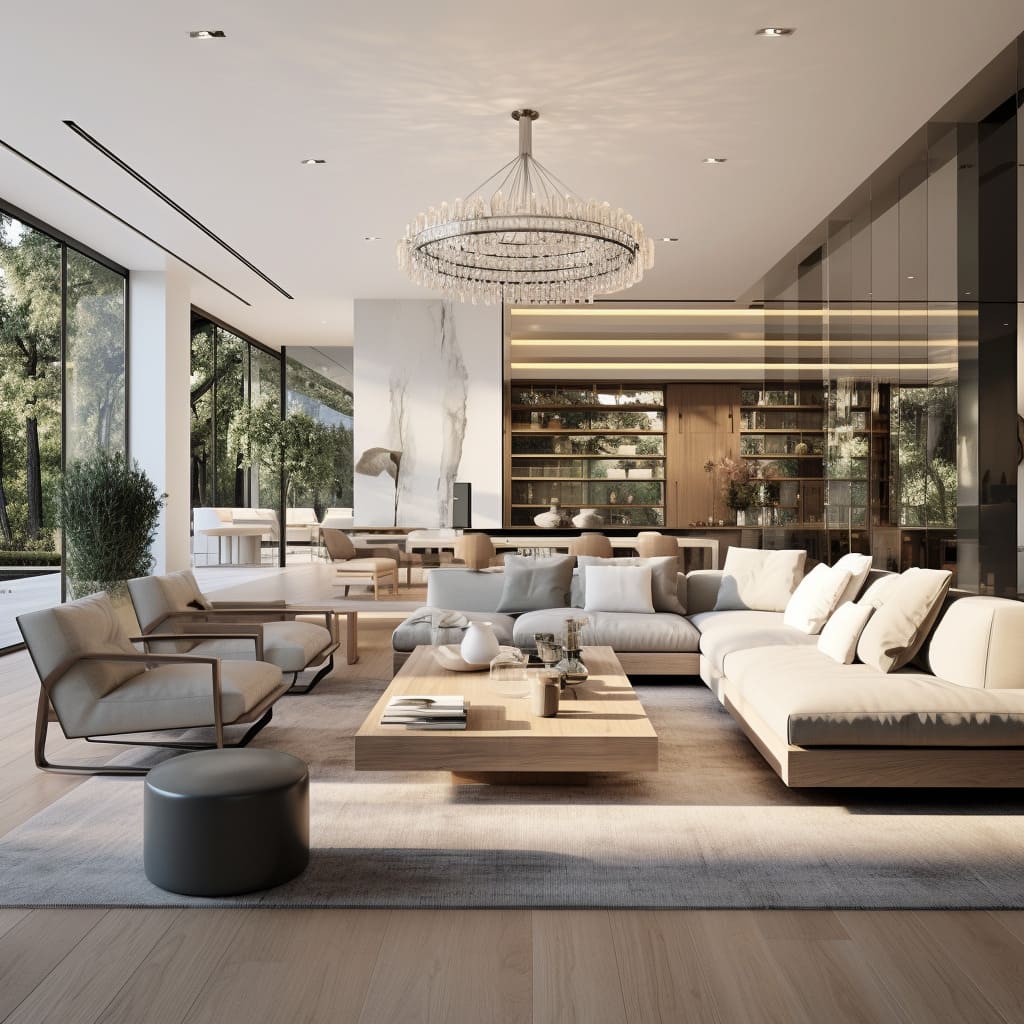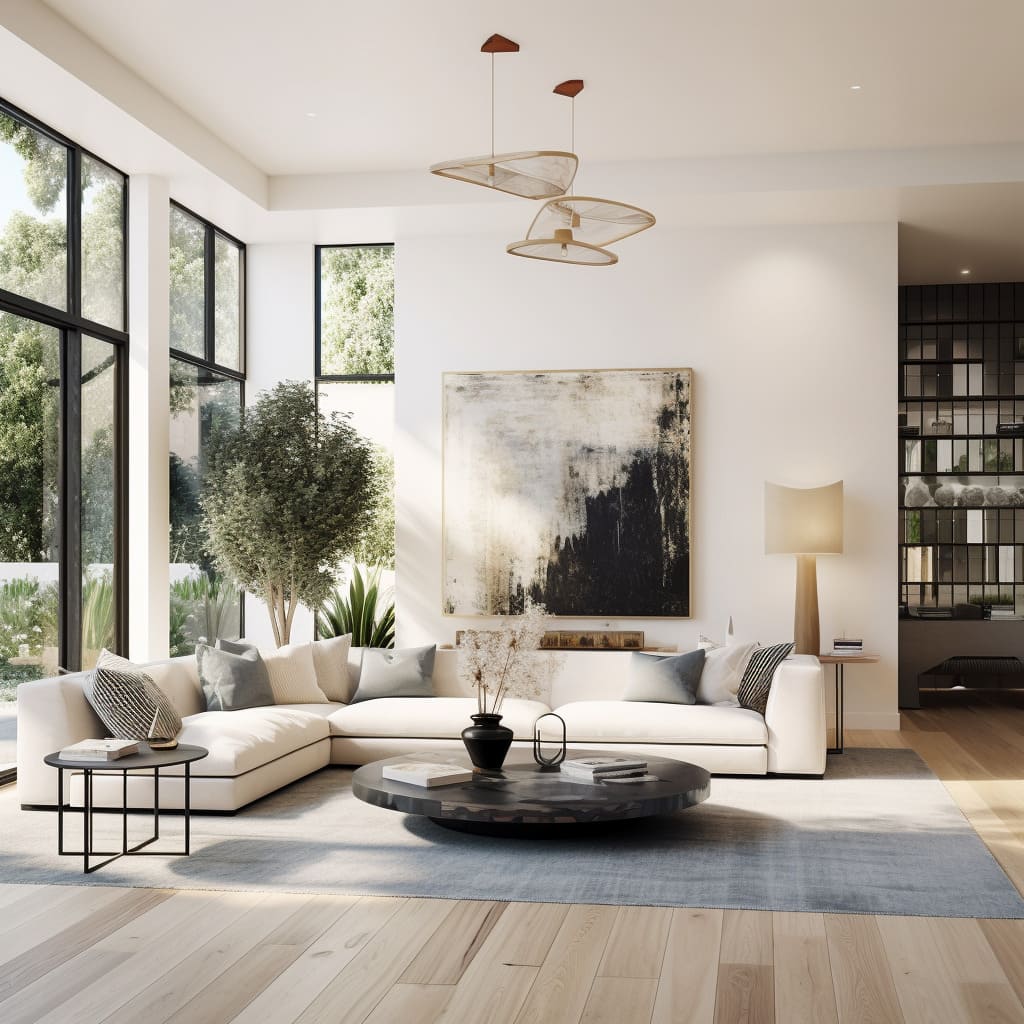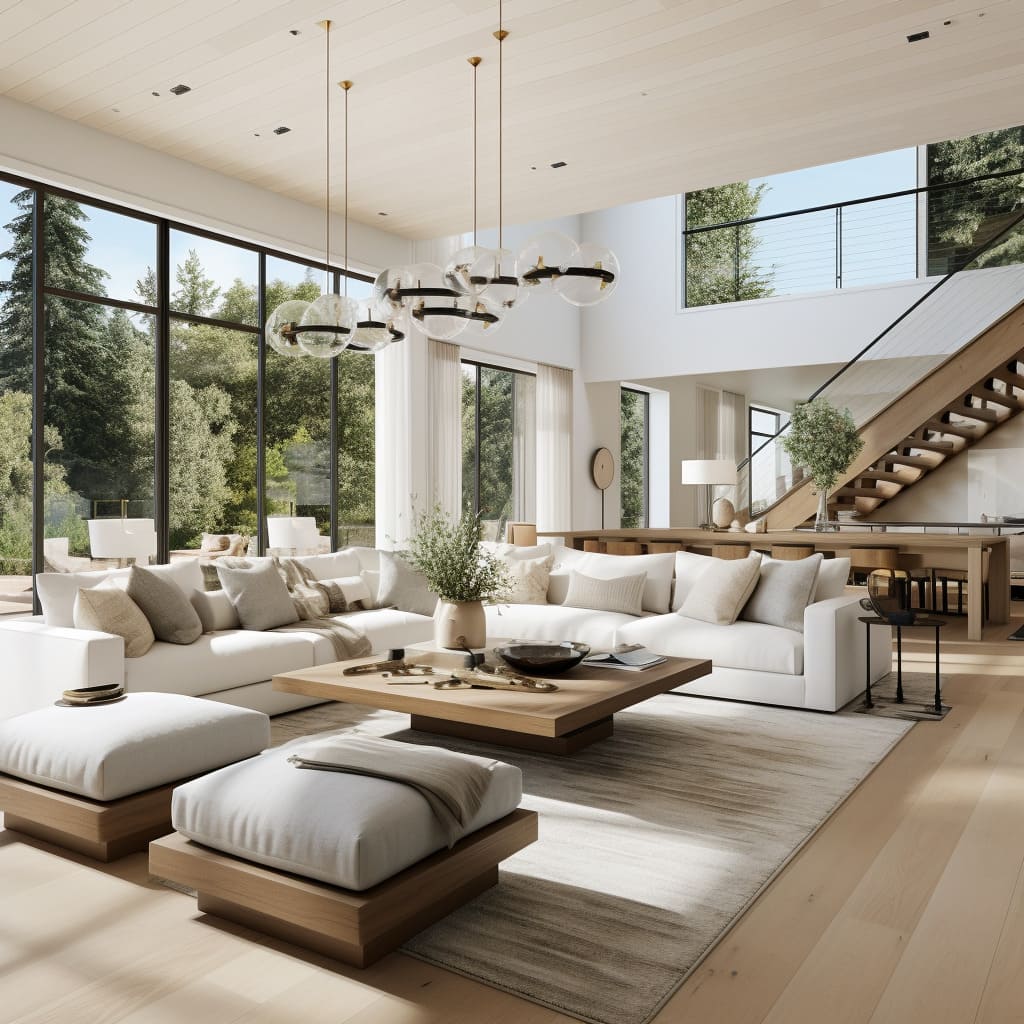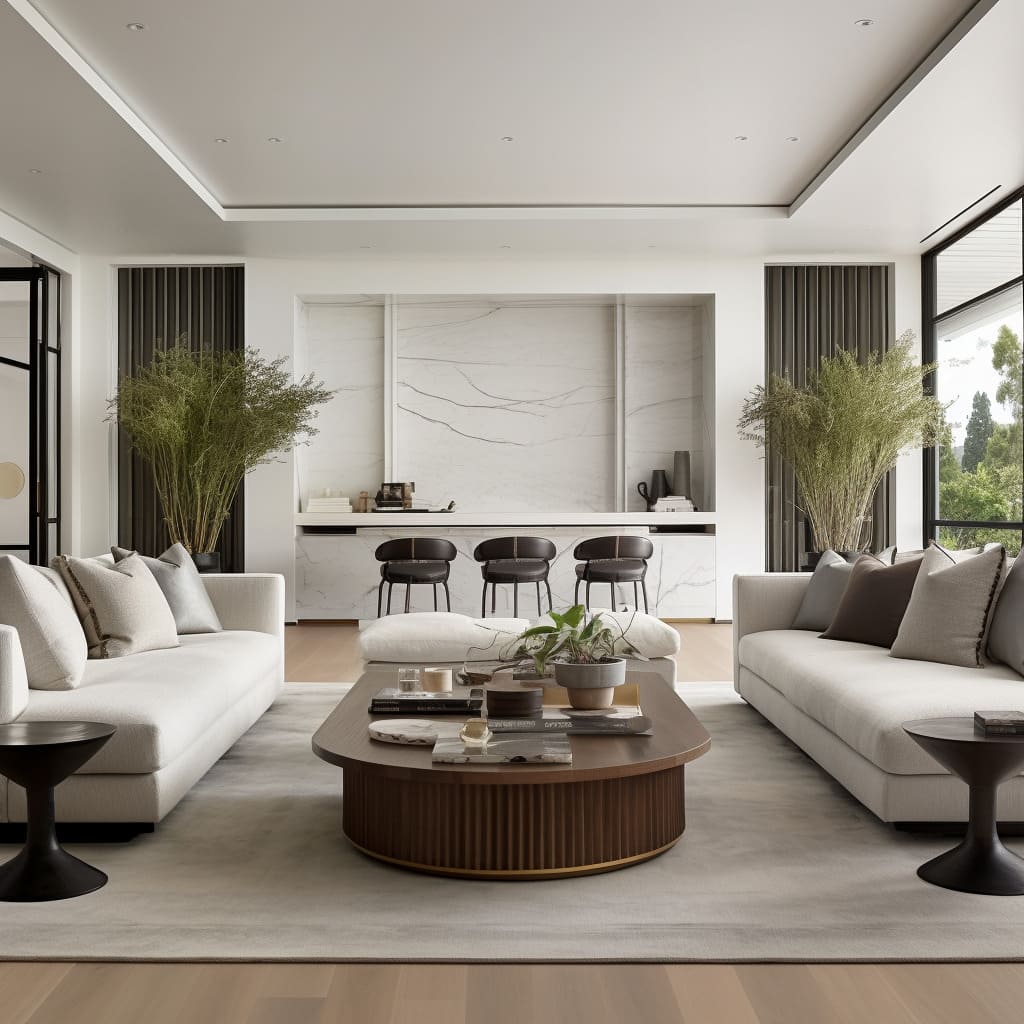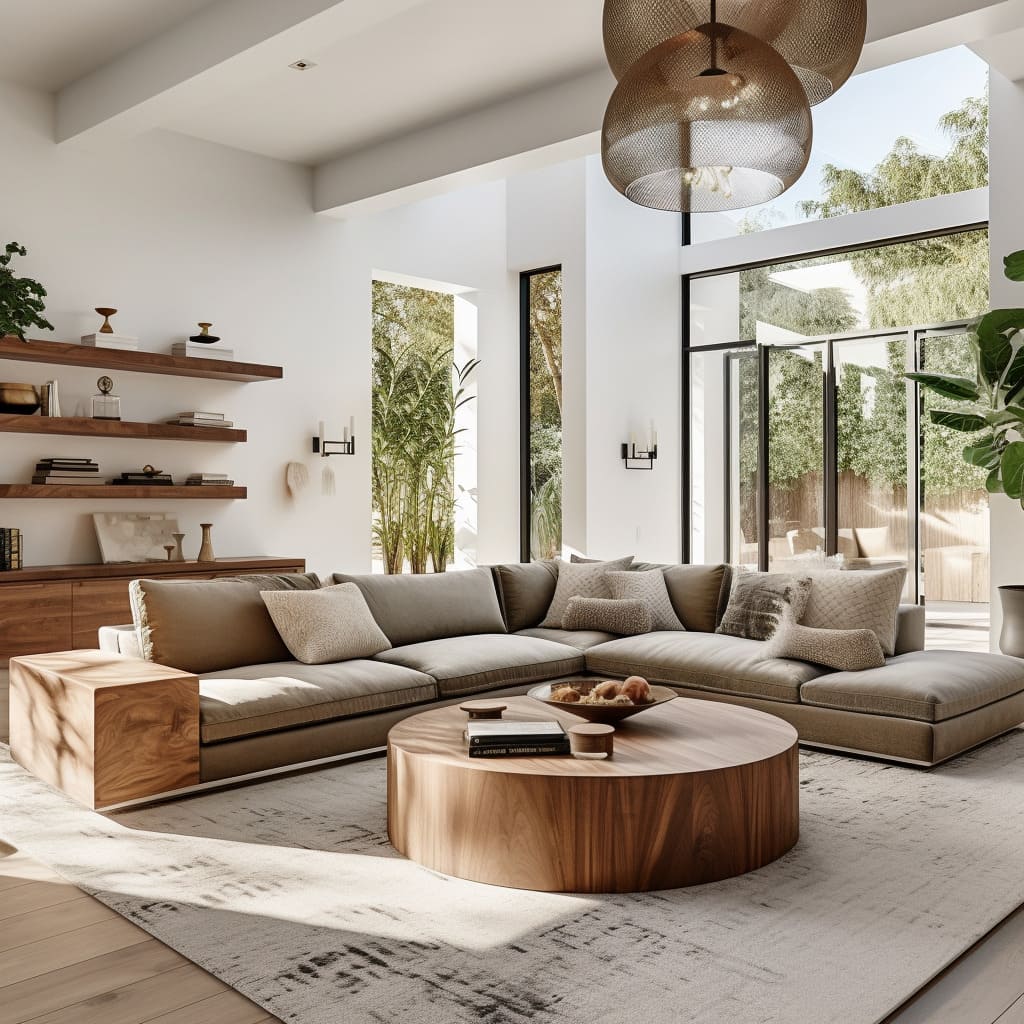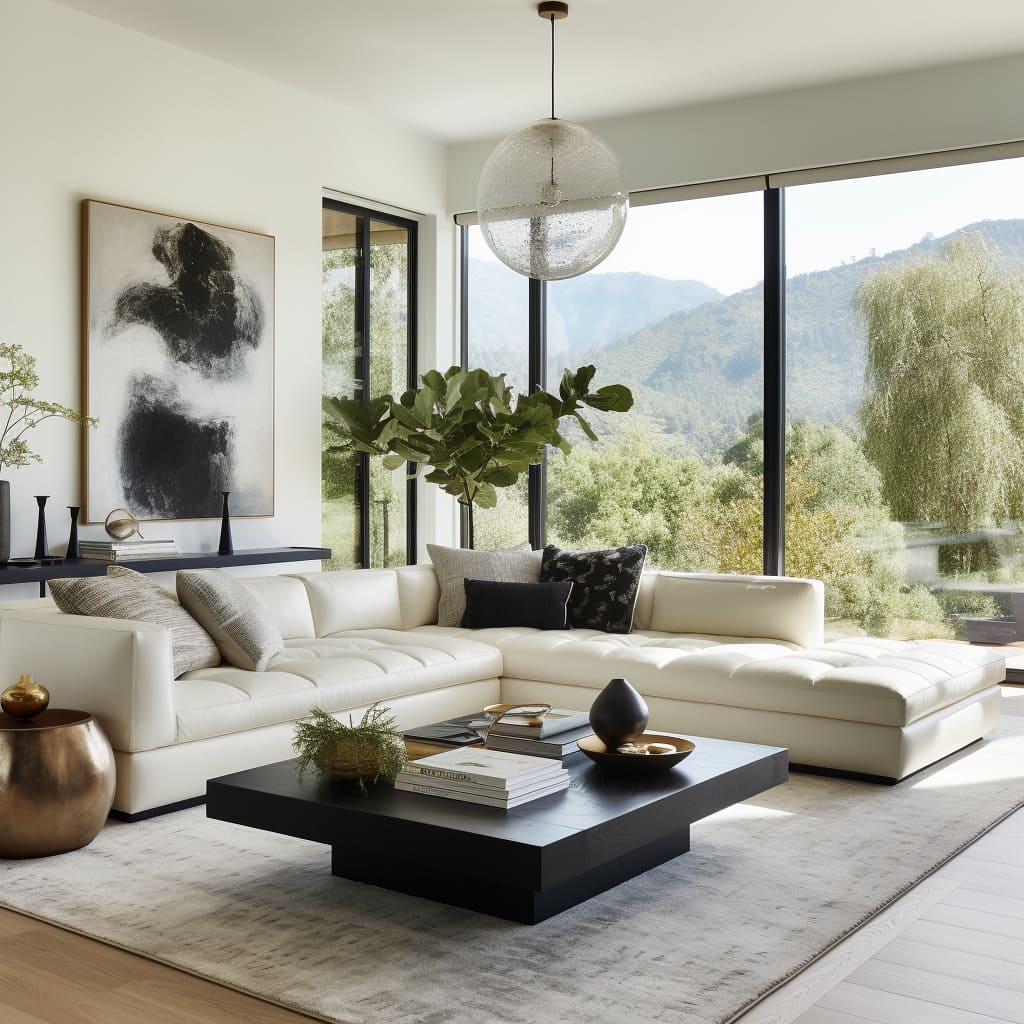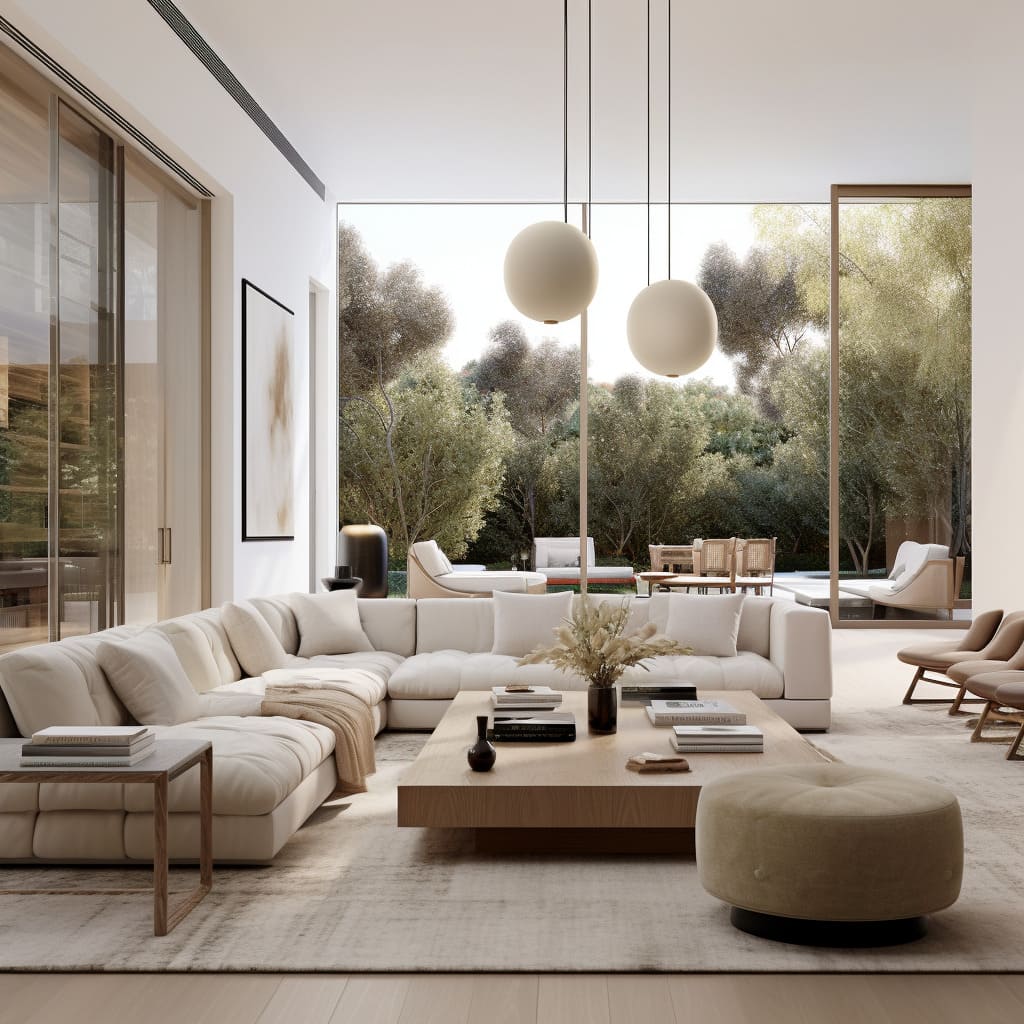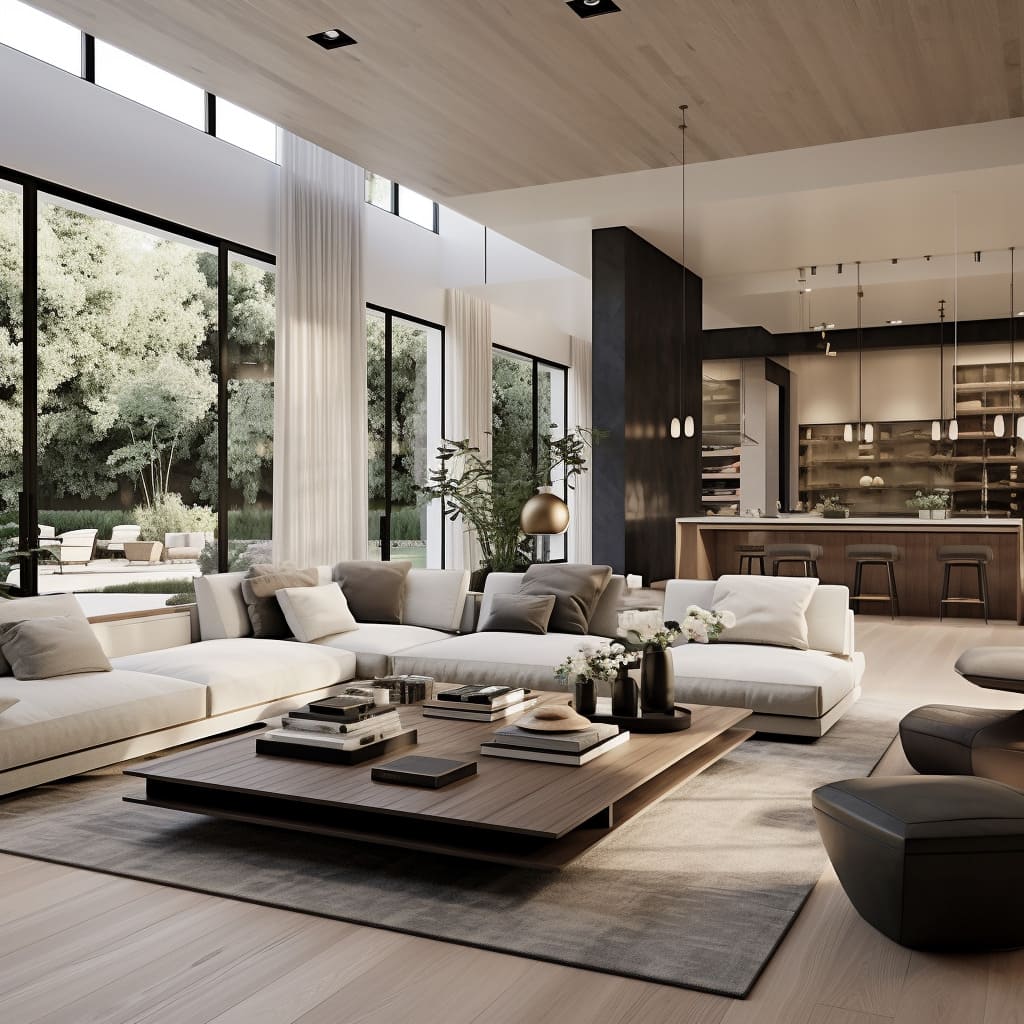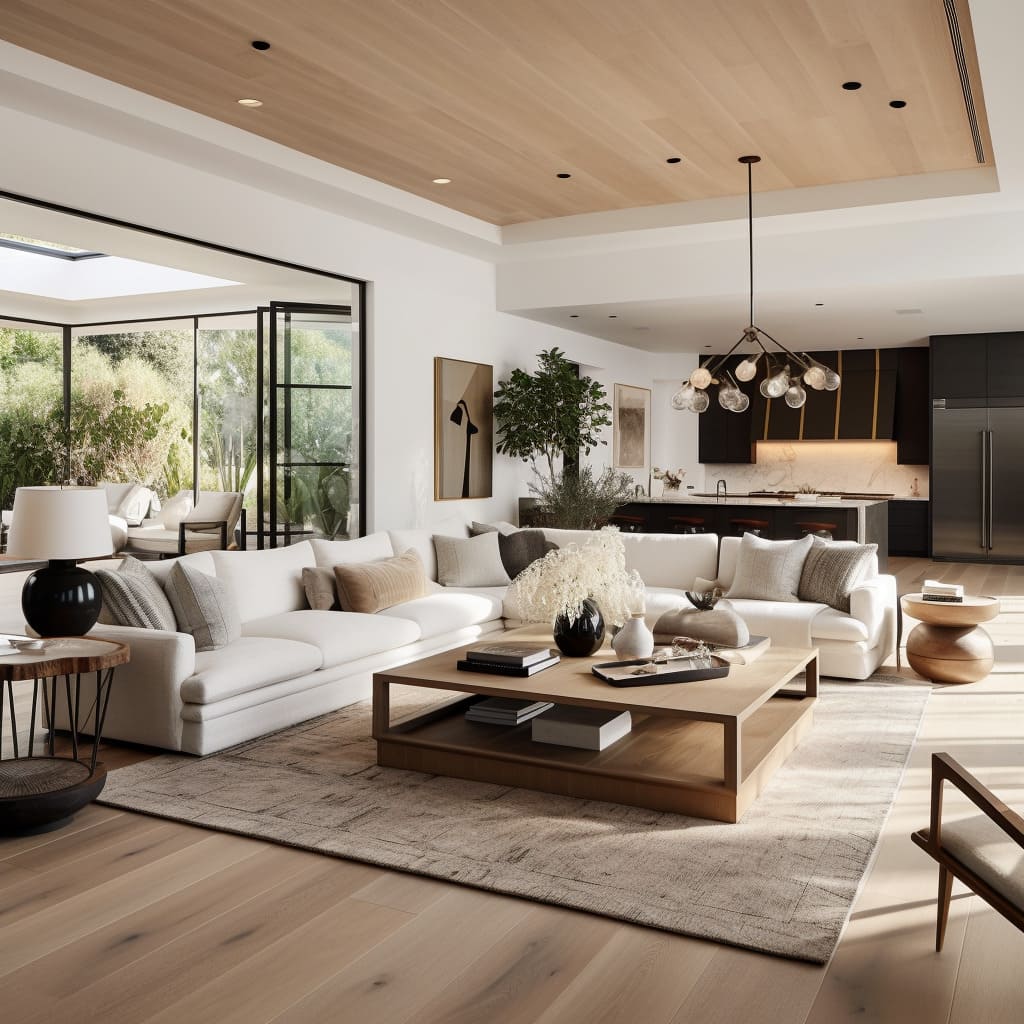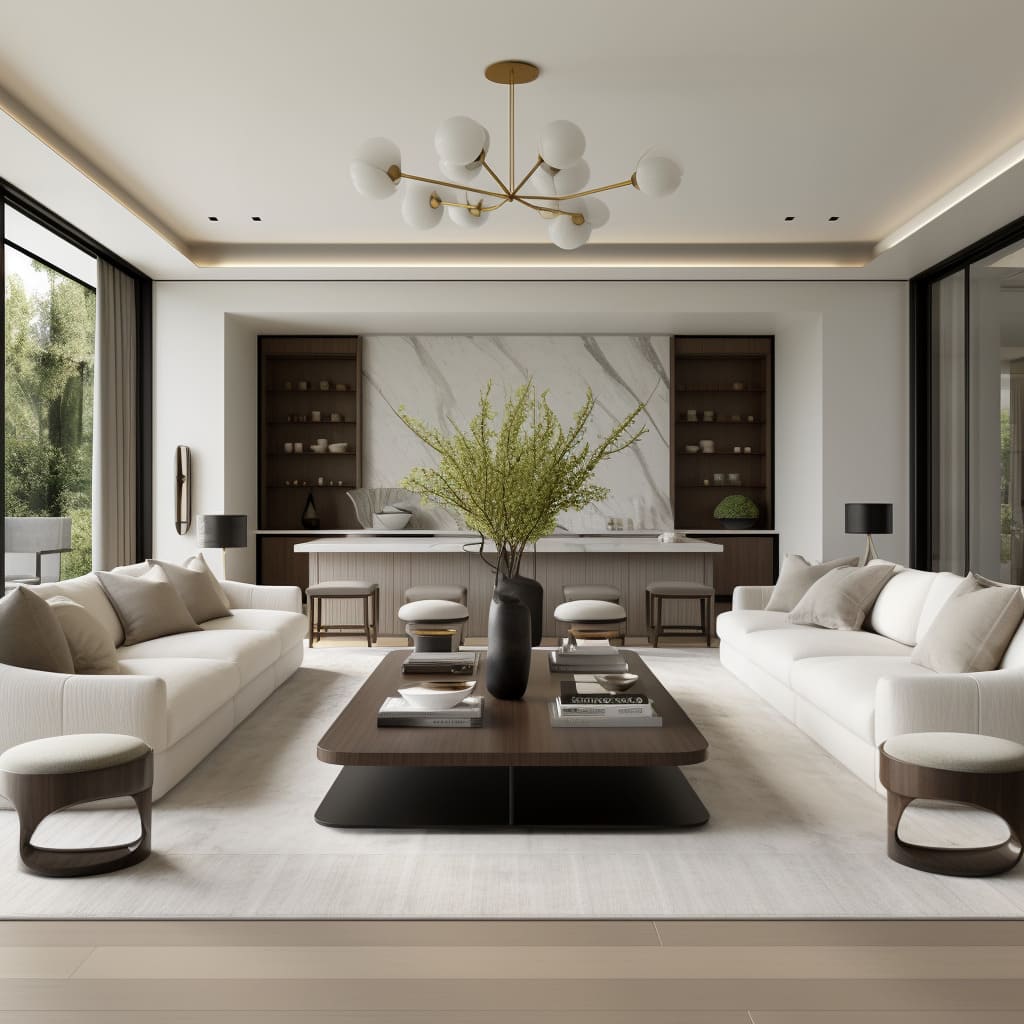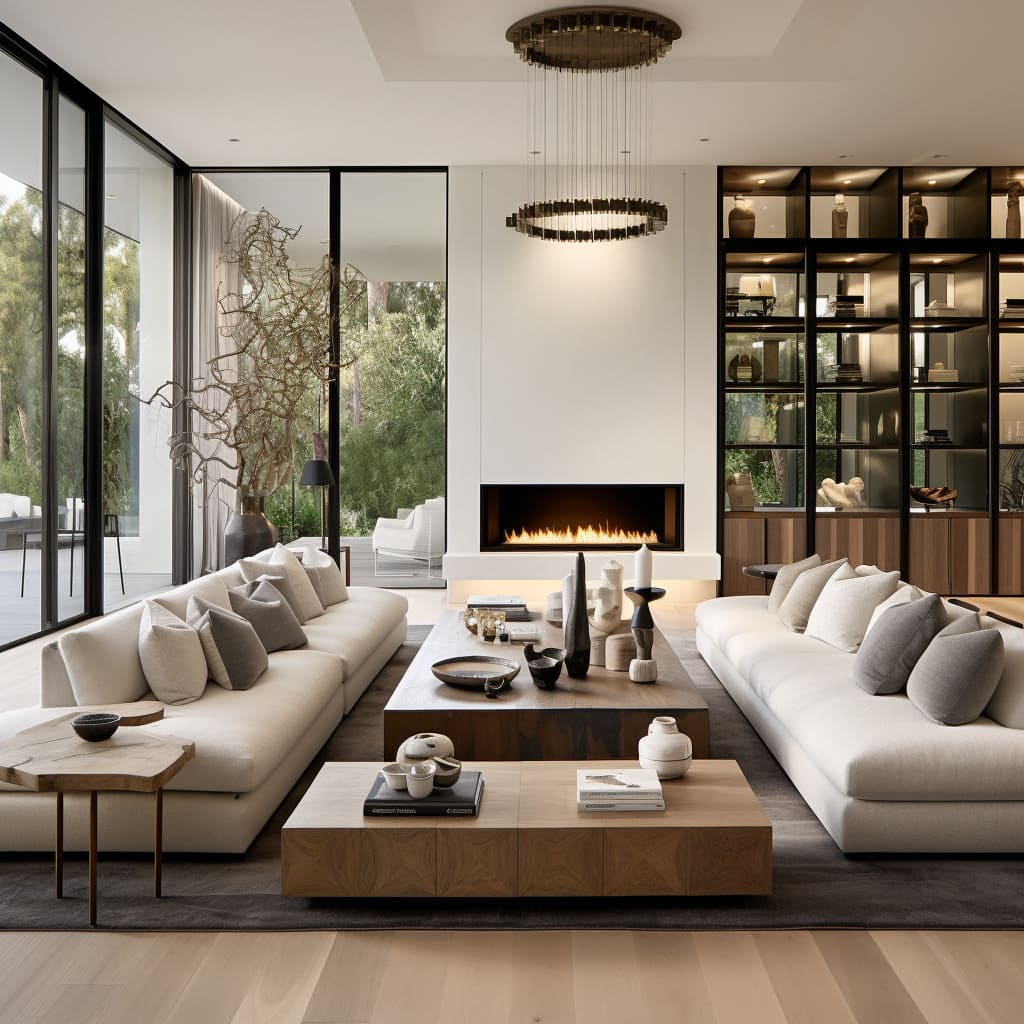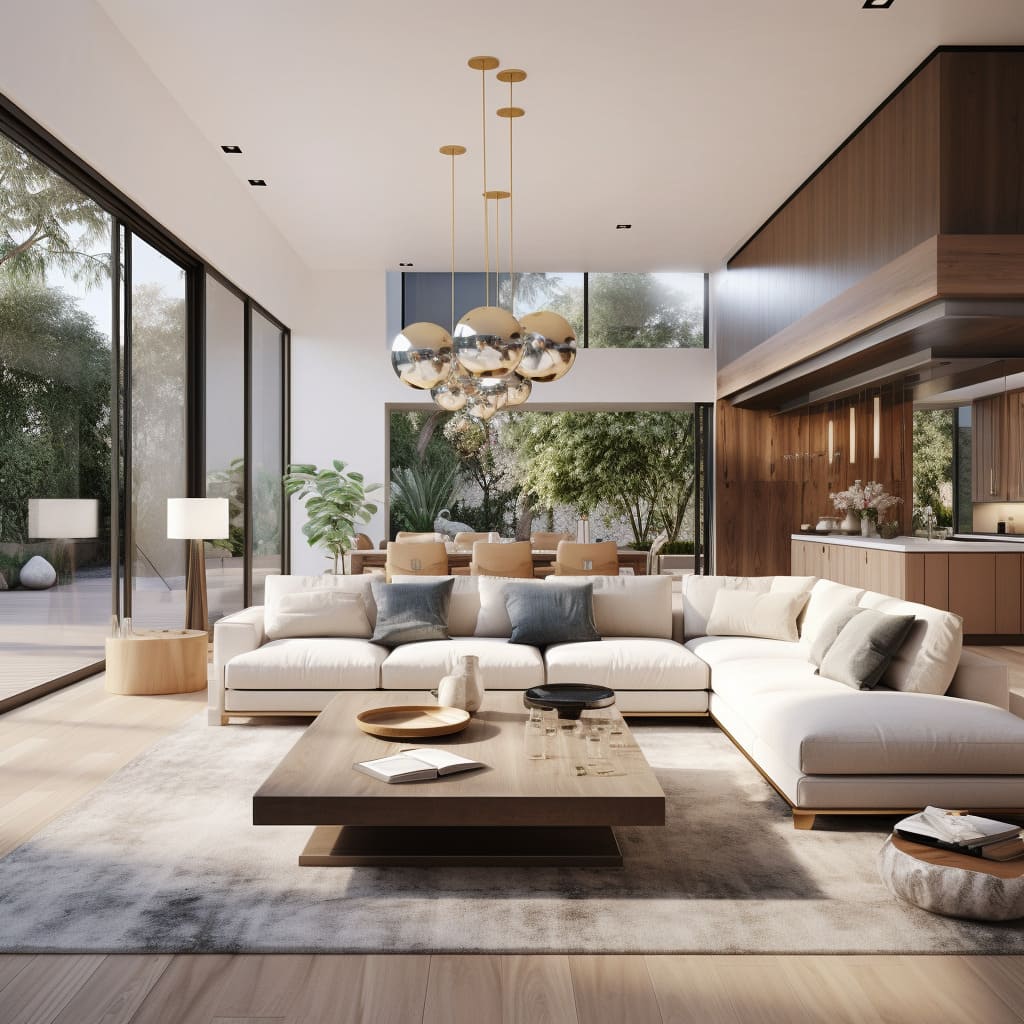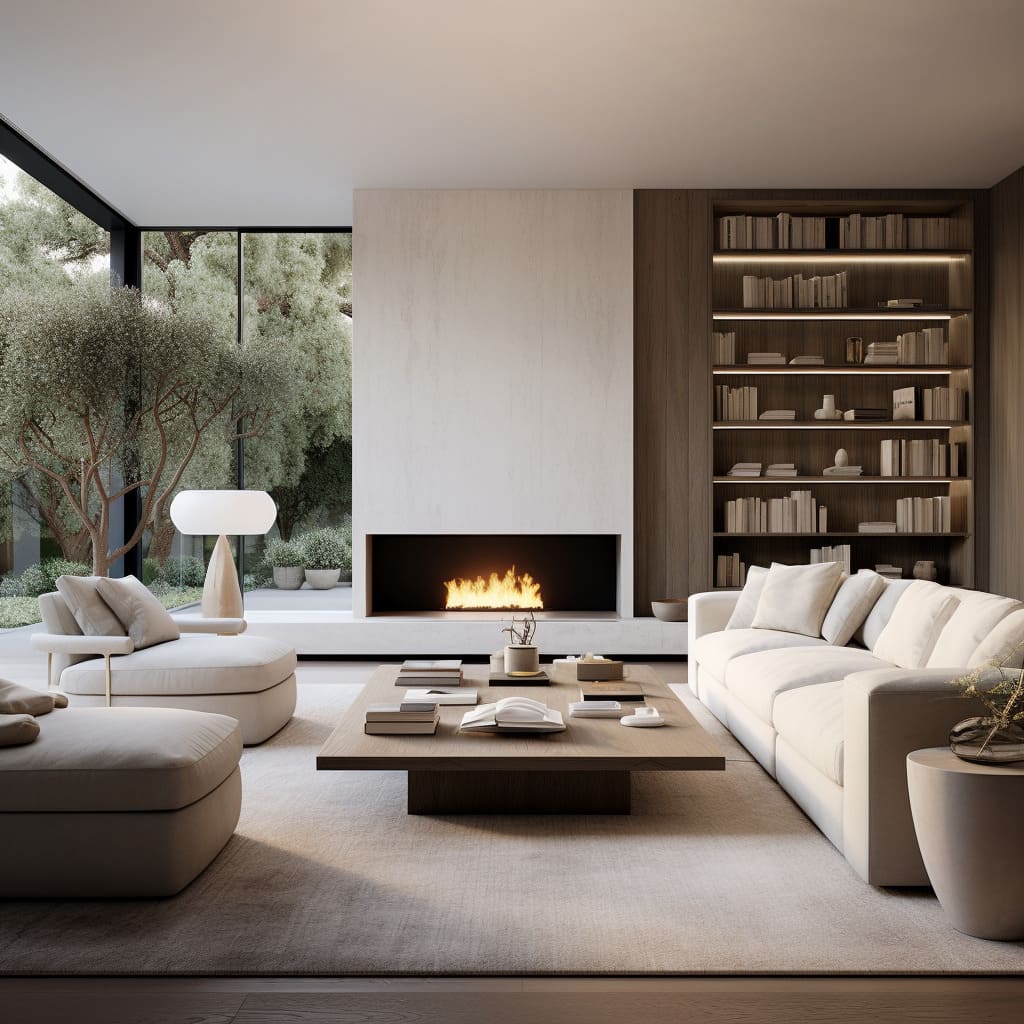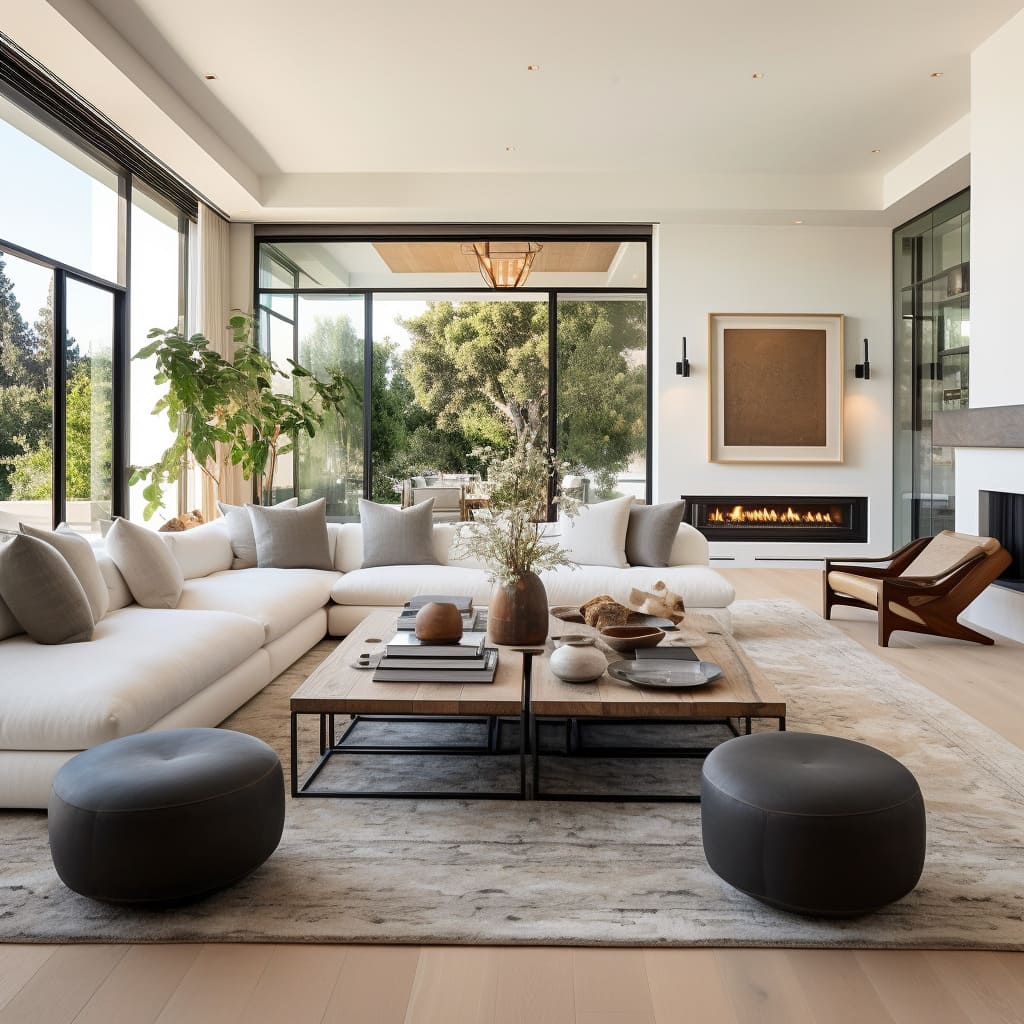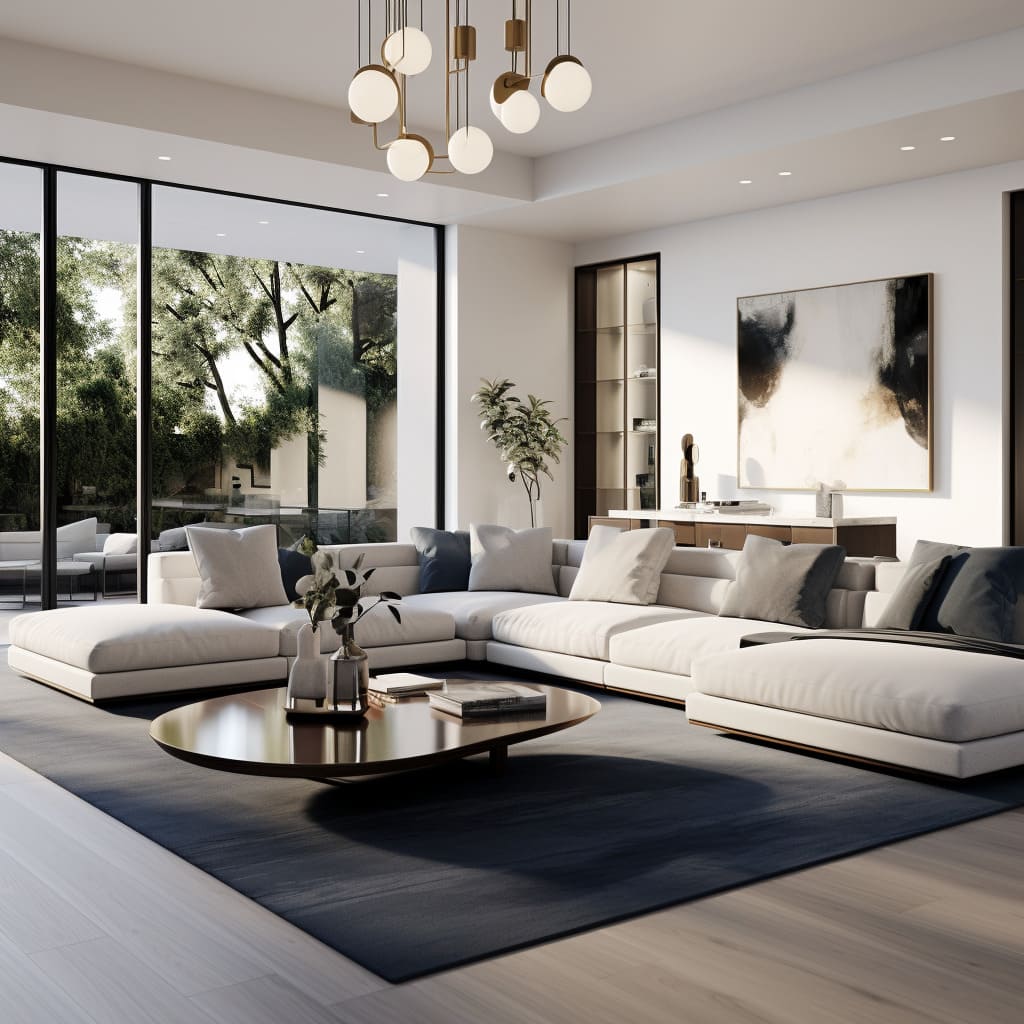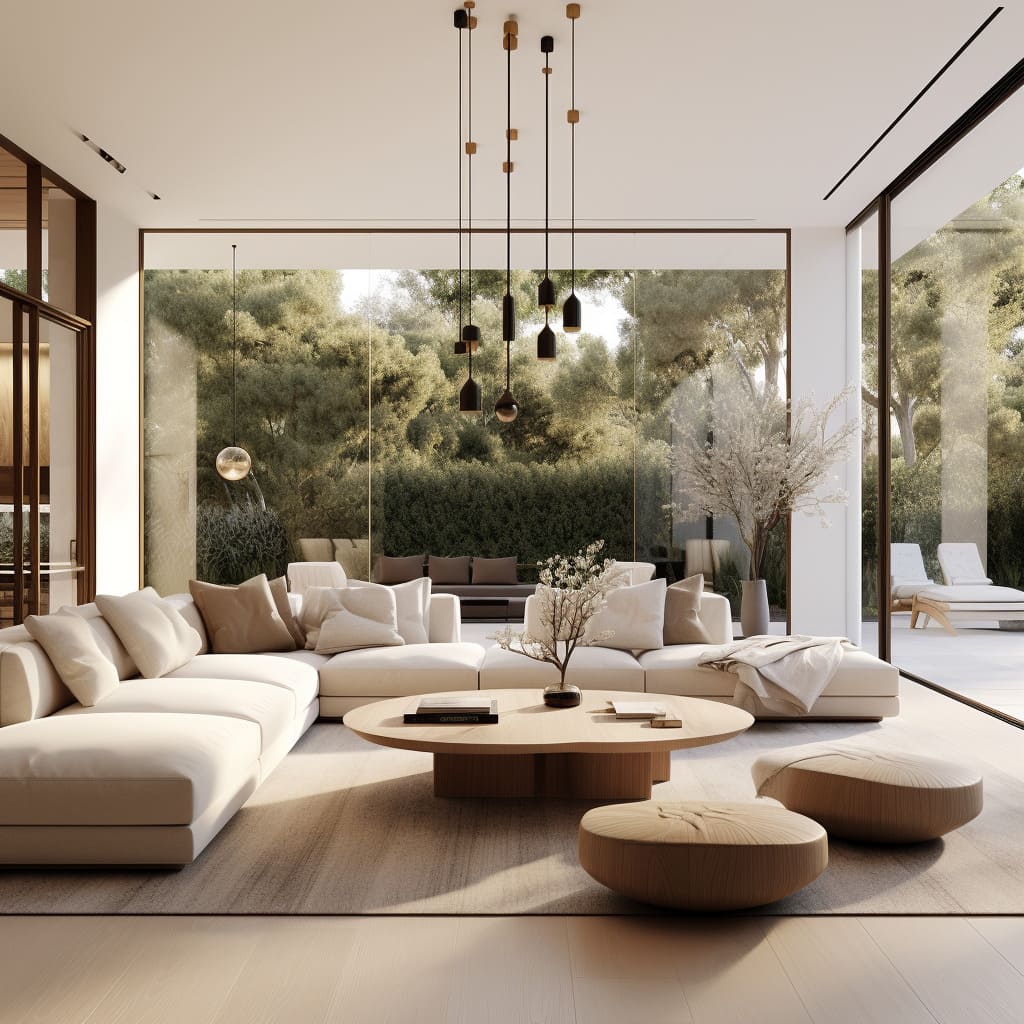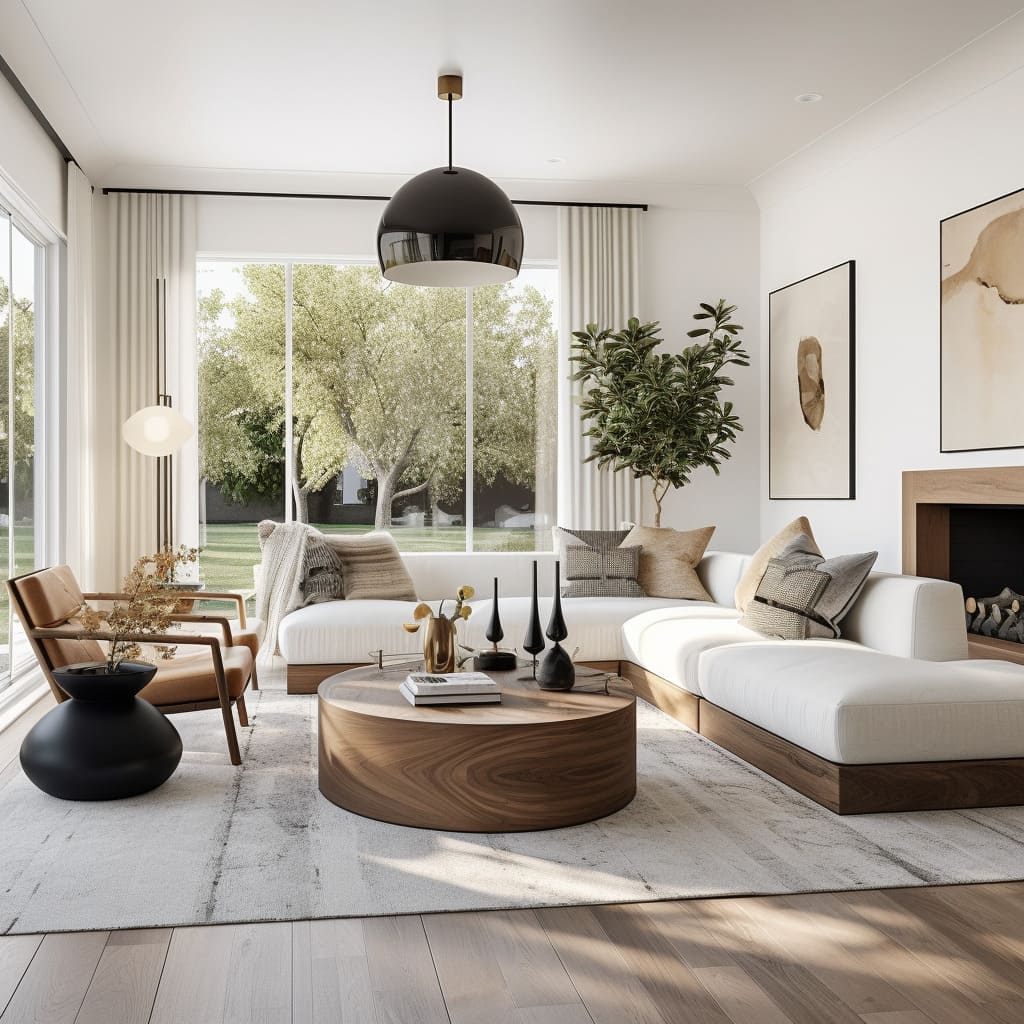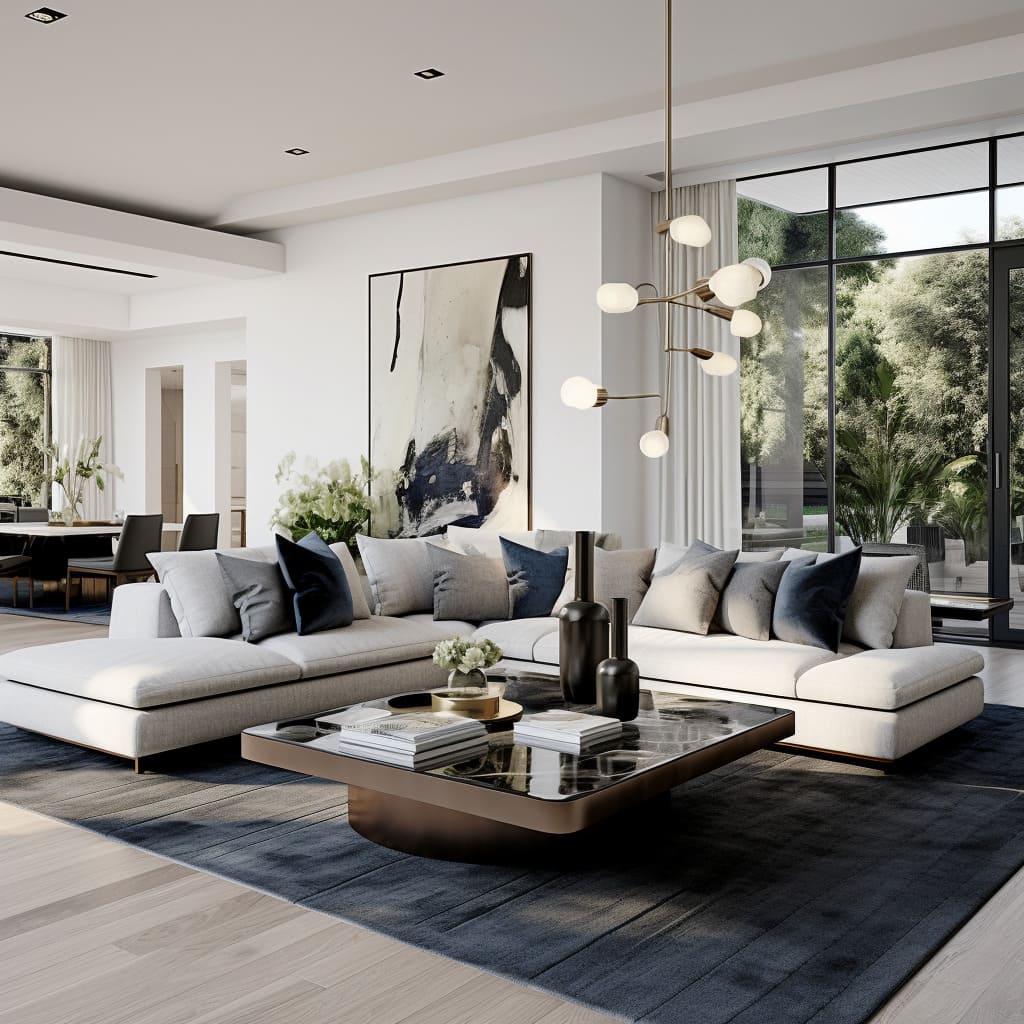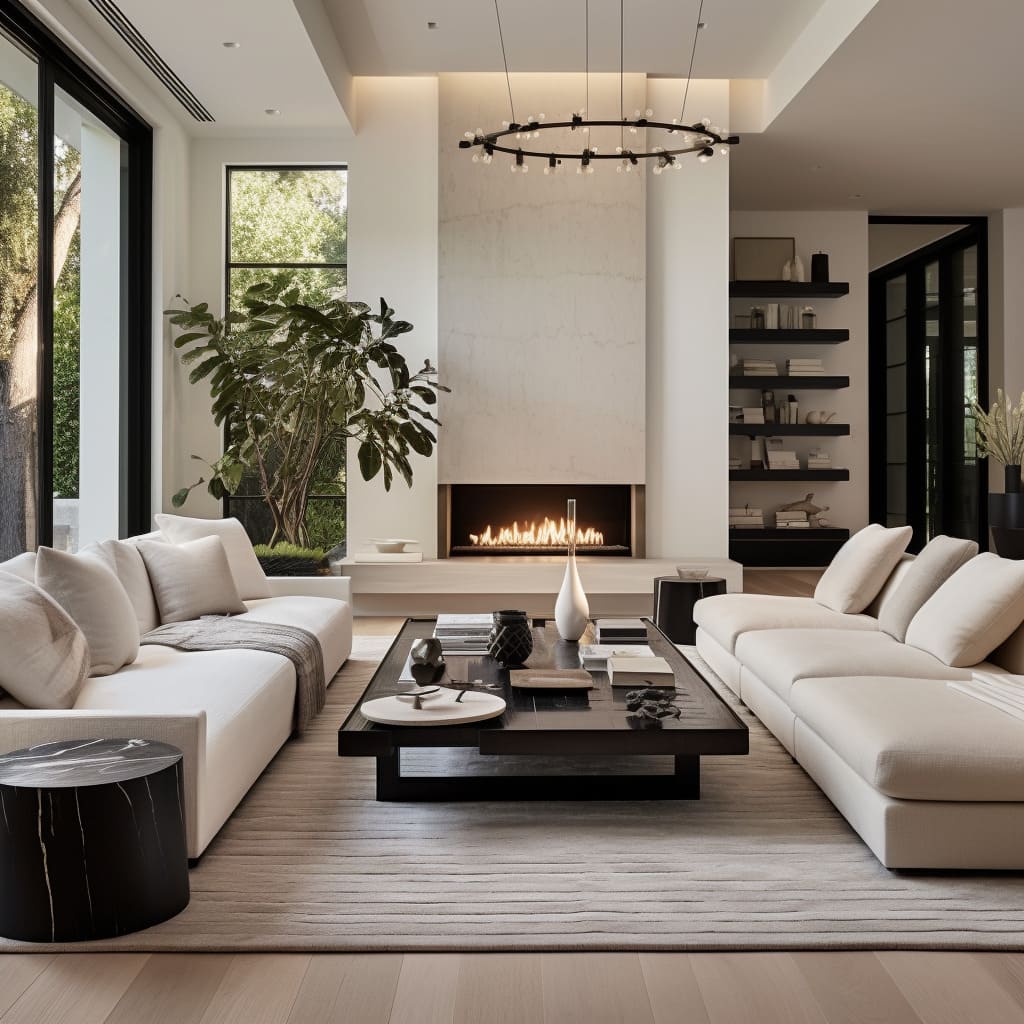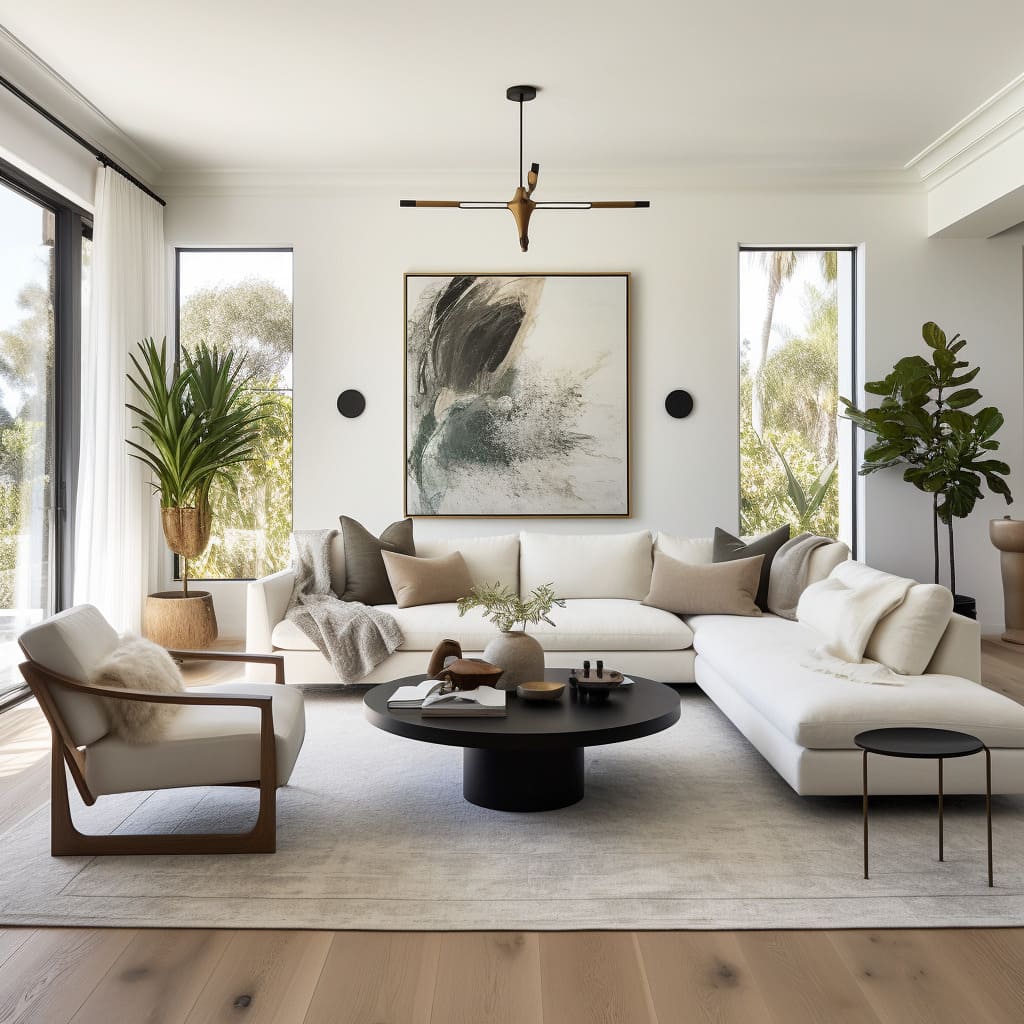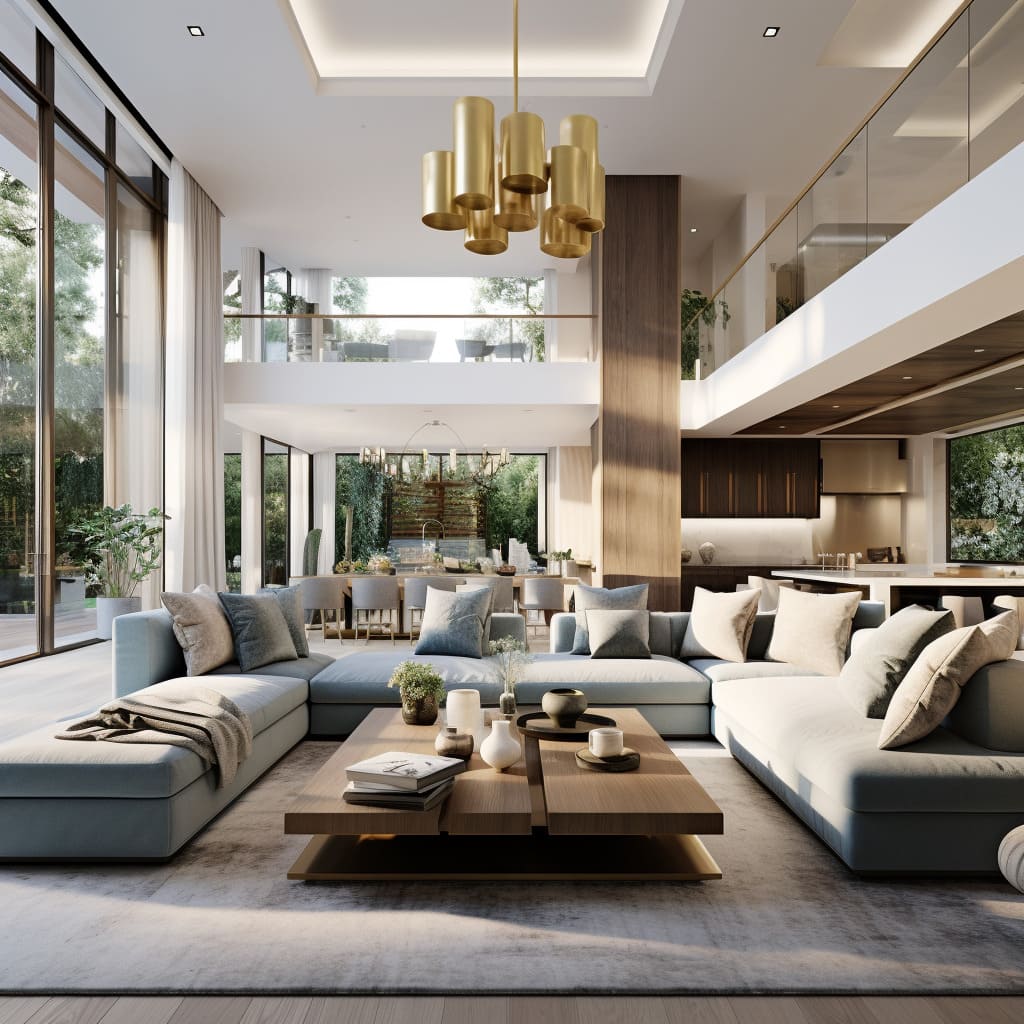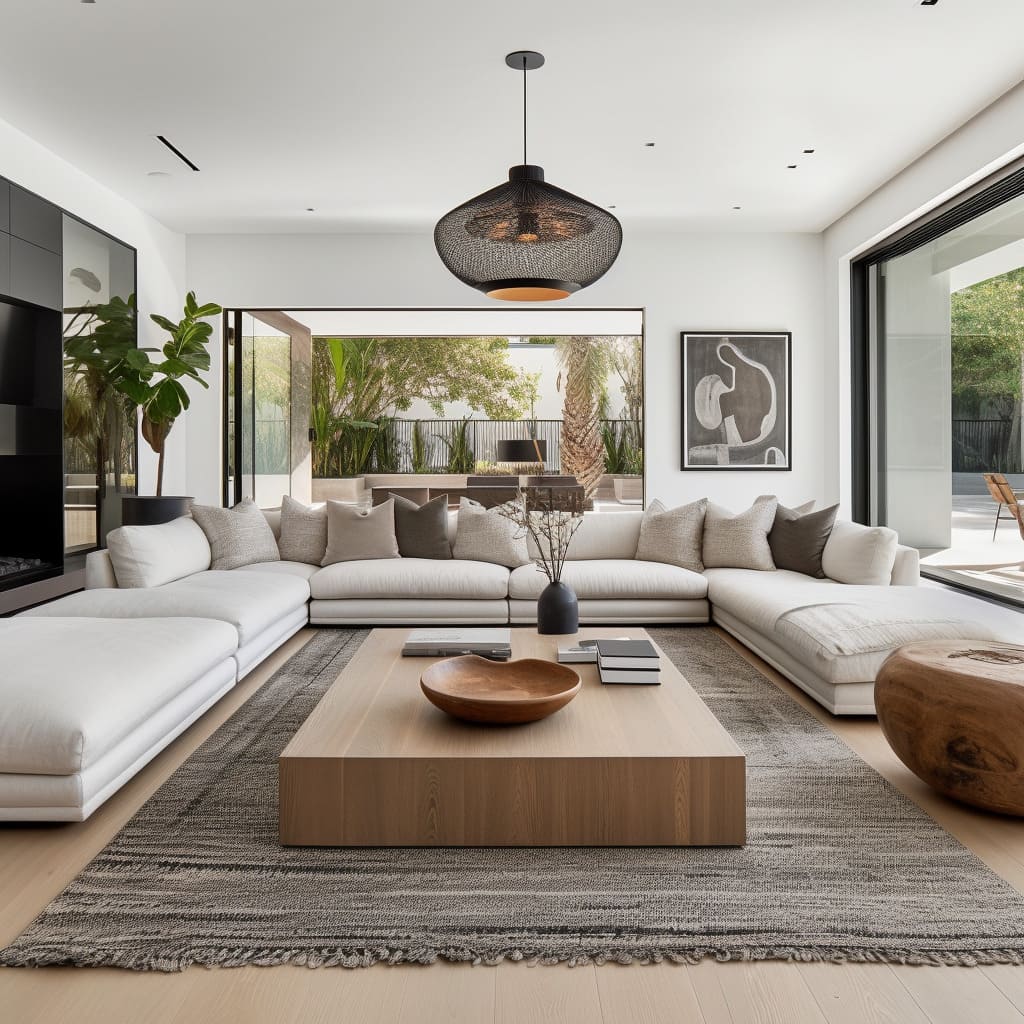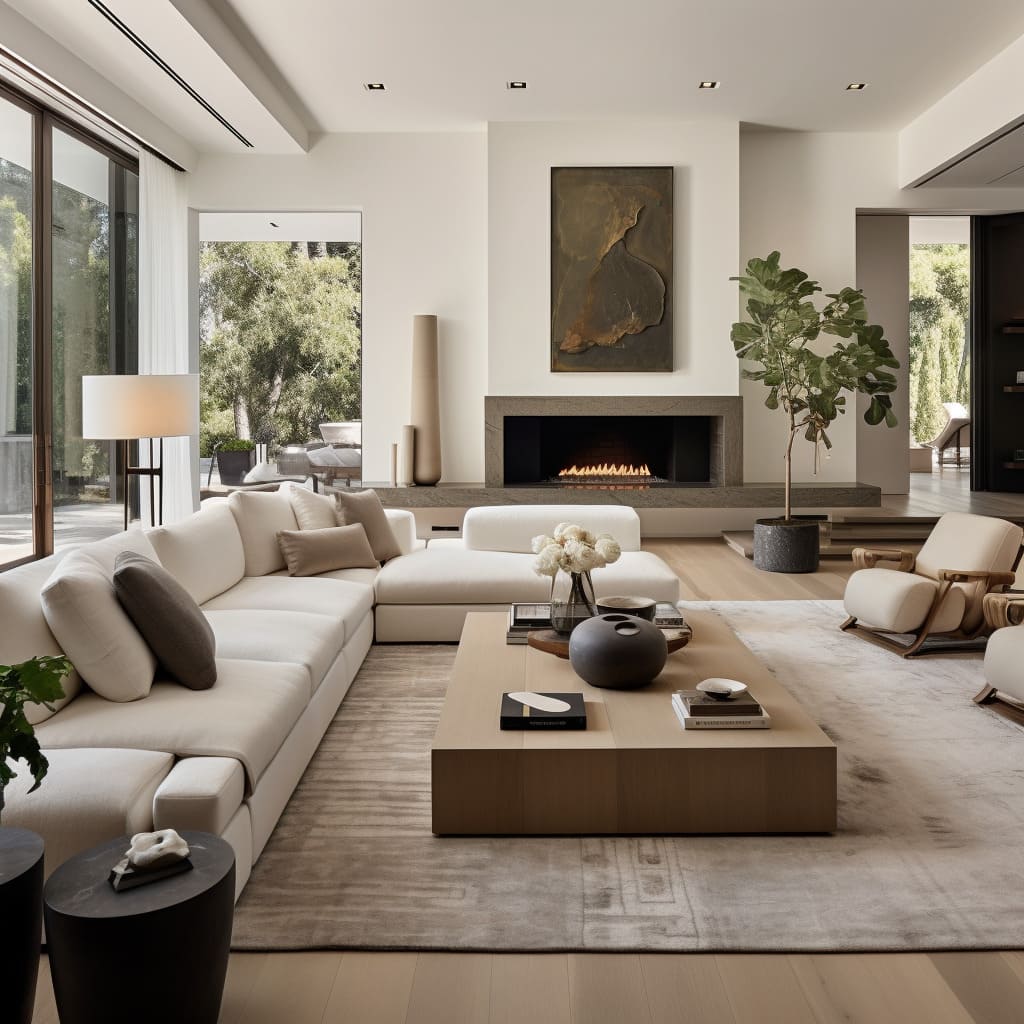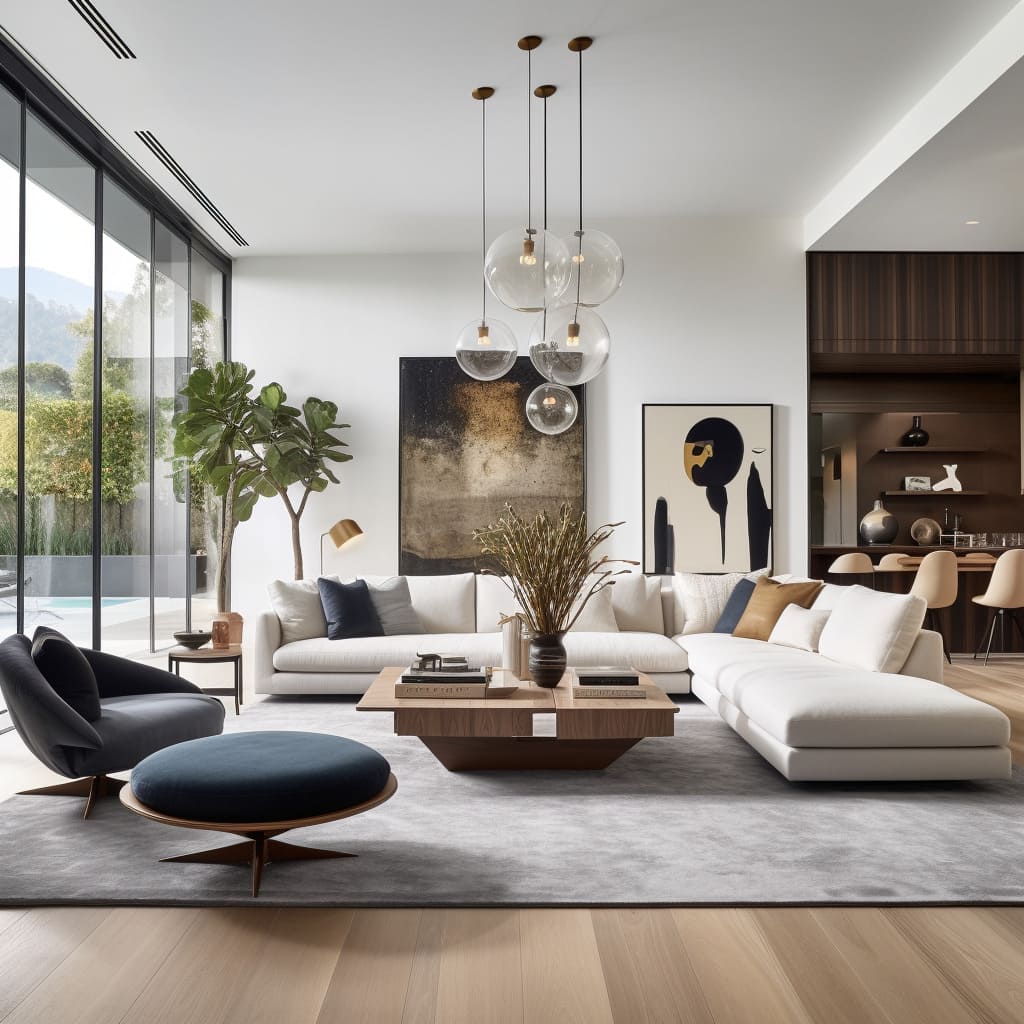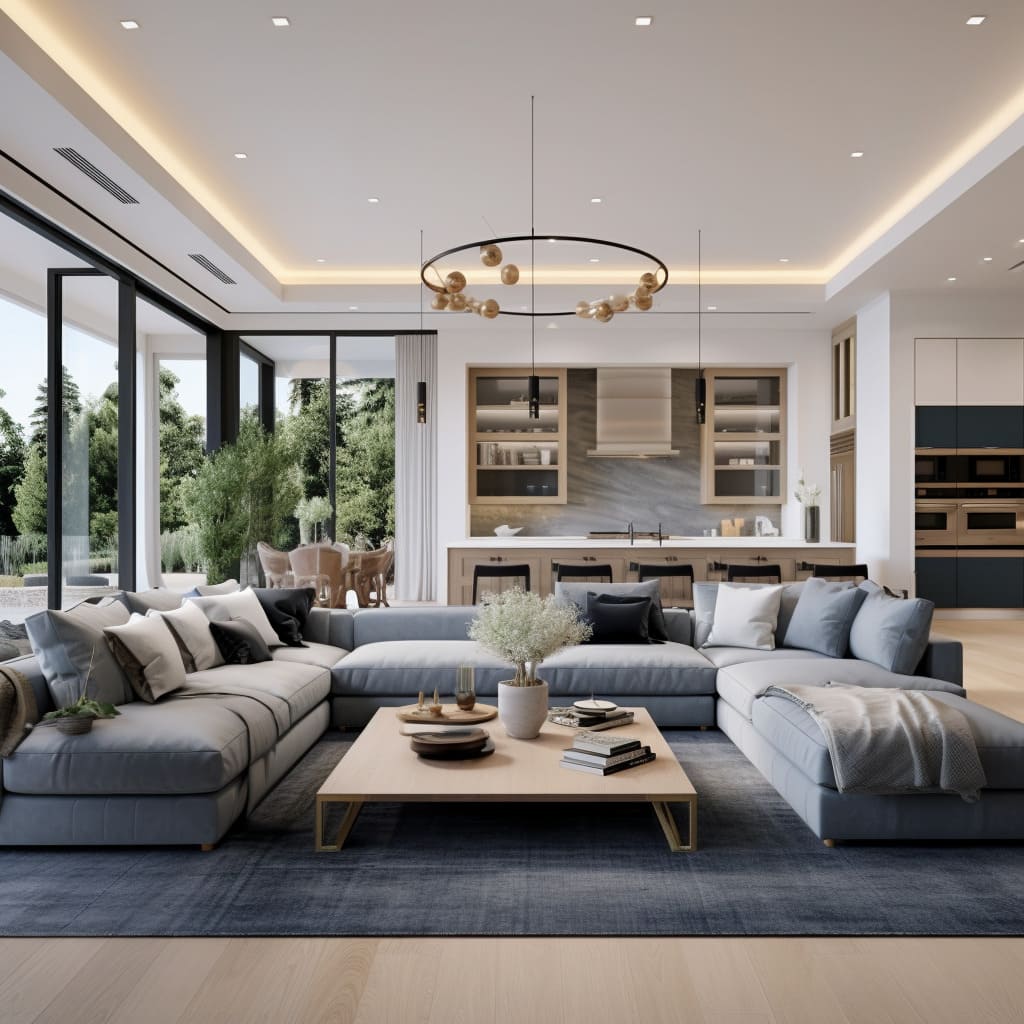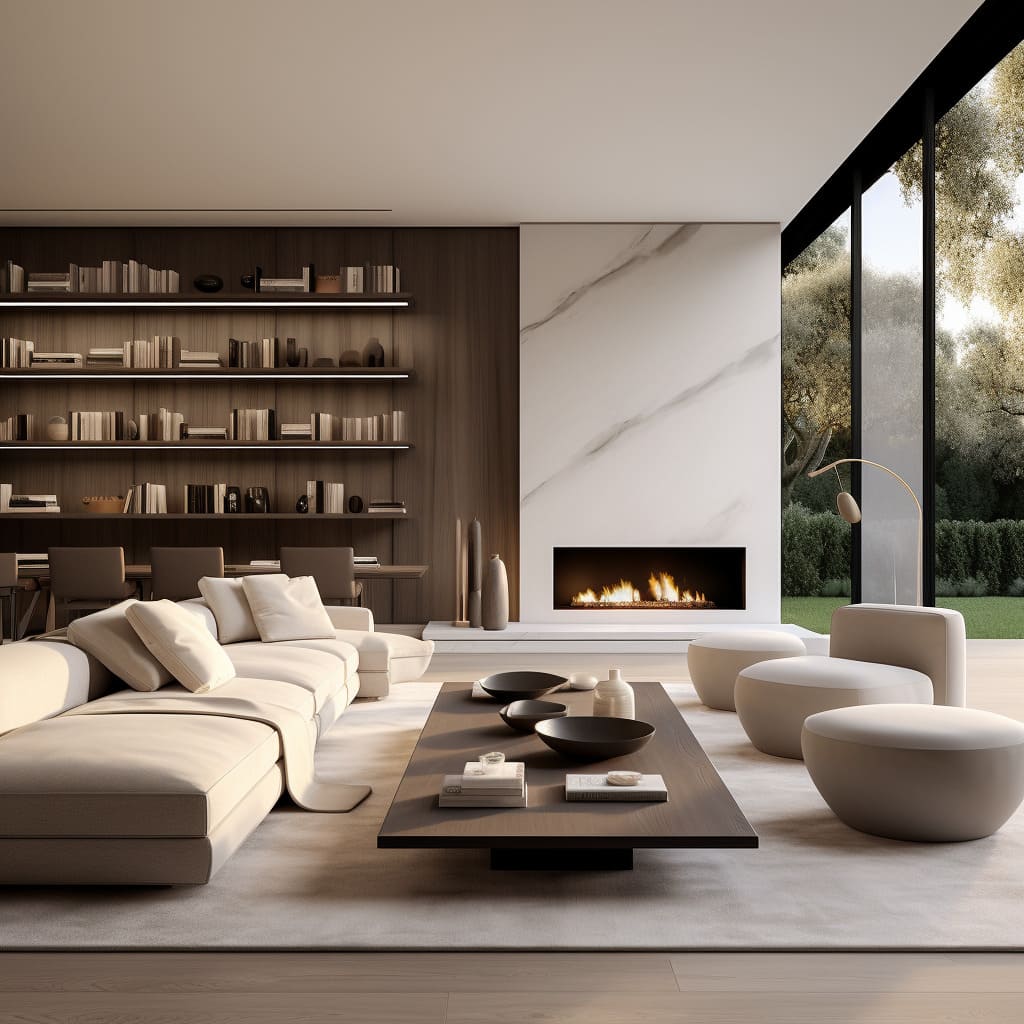Contemporary minimalist interior design marries the elements of modern style with the simplicity of minimalism, emphasizing an open, airy layout. These designs often merge living and dining areas into a seamless space, bathed in a neutral color scheme.
Soft whites, creams, and greys typically dominate, with touches of muted blues adding a sense of calm sophistication.
In such spaces, plush, large seating options like L-shaped sectionals in light cream are common. These are frequently adorned with coordinating throw pillows in harmonious shades of blue, beige, and grey.
The presence of a statement coffee table, often in dark, rich wood with a bold, low-profile design, serves to anchor the space. This contrast between the table’s solidity and the room’s overall lightness is a key feature.
The Coffee Table
In contemporary minimalist interior design, the coffee table ensemble often becomes the focal point. It typically includes two pieces: a larger rectangular table and a smaller round table, both showcasing modern, clean lines.
The larger table is usually a low-lying piece, featuring a substantial wooden top on a sleek black metal frame. The visible grain of the wood adds warmth and texture.
In contrast, the smaller, round table is often finished in a smooth, matte black, offering a visual and tactile contrast to the wooden table.
These coffee tables serve both practical and decorative purposes. They are strategically placed on a textured rug, helping to define the living area in open floor plans.
Personal touches like books, decorative bowls, and small sculptures on these tables add sophistication. The materials and design of these tables are chosen to complement the room’s overall style.
They often echo other elements like the flooring and fireplace, balancing functionality with aesthetic appeal.
Eclectic mix of furniture
Contemporary minimalist interiors are defined not just by their simplicity, but by the eclectic mix of furniture and art that imbues them with character. This blend of elements forges a curated look that is both modern and timeless.
Artwork plays a pivotal role in these spaces. Often, a large abstract painting with dark hues and a textured surface commands attention on one wall, creating depth and intrigue.
This is usually balanced by a more minimalist piece on an adjacent wall, characterized by bold shapes and contrasting colors, adding a modernist touch.
Furniture selections are equally distinctive. A standout lounge chair with dark upholstery and a unique silhouette often adds a modern twist to mid-century design.
This is typically accompanied by a circular ottoman, serving as both a functional and aesthetic piece. Positioned on a plush area rug, these items anchor the space, allowing the artwork and furniture to shine.
These art pieces and carefully chosen furniture items do more than decorate; they cultivate an ambiance of refined comfort. Each piece is selected not just for its utility, but for its contribution to the room’s narrative, transforming the home into a space that’s as much a gallery as it is a living area.
In modern minimalist spaces, the choice of furniture often emphasizes functionality and adaptability. Multi-functional furniture, such as comfy sofa beds, plays a crucial role in maintaining the sleek, uncluttered aesthetic. These pieces not only save space but also enhance the versatility of the living area, providing practical solutions for both lounging and accommodating guests.
Use of texture and layering
In contemporary minimalist interior design, the sophisticated use of texture and layering is key to adding depth and interest. A prime example of this is the area rug, which enhances the seating area with its rich texture and subtle pattern.
This rug often features a mix of high and low pile, creating a tactile surface that is inviting to touch and helps soften the furniture’s sleek lines. Its color palette usually includes natural hues, complementing the wooden elements of the coffee table and flooring.
The pattern is understated, typically with a slight organic motif, contributing to the room’s serene and earthy feel without being overpowering. More than just a decorative element, the rug serves a practical purpose by delineating the living space within the larger room.
It grounds the furniture, creating a cozy area within the open floor plan.
The Open-Plan Kitchen and Living Area
Modern minimalist homes often showcase an open-plan layout, where the living space flows seamlessly into the kitchen. This design eliminates walls, fostering a smooth transition between areas.
A key element in this setup is the large central island in the kitchen, offering ample space for cooking and socializing. It typically includes a sink and cooking area, making it both a functional workstation and a casual gathering spot.
The kitchen’s cabinetry mirrors the minimalist theme, with sleek, handleless units that present a tidy, uncluttered appearance. These cabinets are usually in a light color, harmonizing with the living area’s neutral tones and enhancing the continuity between the spaces.
Task lighting is often strategically placed above the island, either recessed into the ceiling or integrated into a discrete design. This lighting is essential for cooking tasks and also accentuates the island as a focal point in the kitchen.
This open-plan approach promotes interaction between the kitchen and living area, ideal for entertaining or family life. It allows those cooking to stay connected with guests or family members in the living area, creating a more inclusive and sociable environment.
In this design philosophy, the kitchen transcends its traditional role, becoming an integral part of the living space. This reflects contemporary preferences for open, fluid, and interactive living environments.
Consistent color palette
In contemporary minimalist interior design, the key is to create a peaceful and harmonious environment. This is achieved by a consistent color palette and material choice that echoes throughout the space.
The design typically features a range of neutral colors, from light creams to deeper browns. These hues are reflected across different surfaces and textures, adding depth and calmness.
The harmony in color is often seen in elements like wooden flooring, which carries a light, natural finish that blends seamlessly with the soft tones of the furnishings. An area rug, slightly darker yet still neutral, adds texture and helps define the living space.
This thoughtful color matching extends to the cabinetry, usually in warm wooden tones, ensuring a smooth visual flow from one area to another. Moreover, the materials selected, like the soft fabric of sofas and the smoothness of wooden elements, contribute to a sensory experience that’s both indulgent and soothing.
The Chandelier
In contemporary minimalist interior design, a chandelier often stands out as the room’s centerpiece. This lighting feature merges practicality with art, creating a focal point that elevates the room’s sophistication.
The chandelier, for example, with its multi-tiered structure and brushed brass finish, adds a warm, golden touch that complements the room’s neutral tones.
Its design, a blend of cylindrical and disc shapes, introduces dynamism and interest. The decreasing size of the tiers as they rise draws the eye upward, accentuating the room’s height.
This chandelier not only illuminates but also enhances the space’s ambiance, casting a soft glow that highlights other design elements. Serving both as a light source and a central element, the chandelier symbolizes the design’s meticulous attention to detail.
It’s a perfect example of how practical items are selected for their aesthetic contribution in minimalist interior design.
The open-concept layout
Contemporary minimalist interior design often features an open-concept kitchen that blends effortlessly with the living area. This kitchen, defined by its minimalist approach, showcases a striking marble backdrop and countertop, exuding a clean and luxurious feel.
The subtle veining in the marble adds depth and sophistication. In keeping with the minimalist theme, the kitchen cabinetry is designed to be flush and handle-free, enhancing the sleek, modern look.
The upper cabinets merge into the marble wall, maintaining uncluttered lines, while the lower cabinets and island, in neutral tones, align with the living area’s color scheme.
Above the island, elegant dark-toned stools with slender legs offer a striking contrast to the light marble. These stools provide not just seating but also a spot for casual dining or socializing, all the while embodying the room’s affinity for simplicity and fine lines.
This kitchen exemplifies modern design’s fusion of functionality and elegance. The careful selection of materials and colors crafts a cohesive, welcoming space.
Its integration into the living area highlights the home’s dedication to open, fluid living spaces, a hallmark of contemporary minimalist design.
In conclusion, contemporary minimalist interior design is a testament to the beauty of simplicity and the power of thoughtful detail. From the tranquil harmony of neutral color palettes to the understated elegance of materials like marble and wood, each element is chosen for both its aesthetic and functional value.
The design’s defining features, such as the sleek cabinetry, the artful chandeliers, and the seamless integration of living and kitchen spaces, all contribute to an atmosphere of sophistication and calm. This approach to design not only creates visually stunning spaces but also fosters a sense of serenity and order, making the home a true sanctuary.

